Why International Karate Plus Was a Unique Fighting Game
It's one of the first ninja video games. Join us as we revisit the might of IK+...
This article comes from Den of Geek UK.
I don’t know how I first learned that you could do it. All my friends seemed to know how to do it, but I doubt they’d remember how they discovered it either. I guess it was just one of those things. You’re young. You have a lot of time on your hands. You experiment. But somehow we all knew. If you pressed a secret key while playing International Karate Plus, the fighters’ trousers would fall down and they’d look embarrassed. This was maybe the funniest thing I’d ever seen when I was a kid.
It’s the little details that can make a martial arts game memorable. The trouser drop may seem like an irrelevant lark, but it was one of many colourful touches that helped cement IK+ as a favorite of my formative gaming years. There were a few customizations in there too that made its “world” seem more real, like being able to change the color of the judge’s jacket (and eyebrows) or being able to modify the sunset style. This level of control was unusual back in the 80s and, while none of it was quite as entertaining as the trouser drop, it all added to the fun.
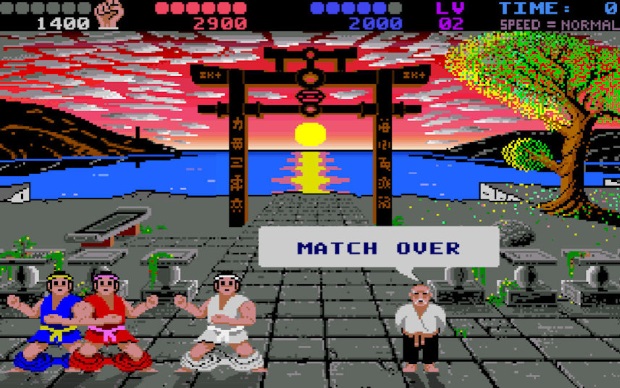
The man responsible for this fun was Archer MacLean, one of the pioneering geniuses of 8-bit programming. You couldn’t call him prolific by any stretch, but all of his games showed flair and innovation far beyond the norm. His debut, Dropzone, was a Defender-style side-scroller with a jetpack-wearing astronaut blowing up alien invaders on Jupiter. What it lacked in conceptual originality it made up for in state of the art graphic design and player control, becoming an arcade clone that actually surpassed the original game.
After Dropzone became a top seller, MacLean was hired by struggling software house System 3 to “fix” a game they’d been working on called International Karate (or the less-catchy World Karate Championship if you were in the US). The original programmer had left a ton of apparently substandard code behind so MacLean decided to rewrite from scratch, throwing himself into the world of fighting games, determined to make the best one (which, at the time, he firmly believed was Way of the Exploding Fist).
In November 1985, MacLean’s shiny new International Karate was released to positive reviews and big sales numbers. It came at the end of a golden year for fighting games (Konami’s seminal Yie Ar Kung-Fu was also released in 1985), but IK still stood out. It had convincing action (the punches actually connected for a start), impeccable graphics motion, and addictive gameplay, as fighters moved up from white belts to the ultimate black belt goal by winning karate bouts, all watched over by a chatty little silver-haired judge. In between fights, there were bonus rounds where you could smash piles of wood using only your head, soundtracked by a mutoid, wildly off-key version of Ryuichi Sakamoto’s Merry Christmas Mr. Lawrence theme music.
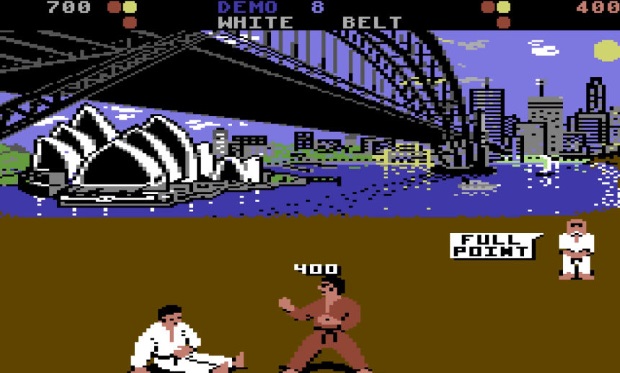
It may seem silly now but one of the best things about the game was, as the title suggested, it really was an international tournament. The background would change so you’d be fighting in Sydney Harbor one minute and outside the Great Pyramid of Giza the next (Street Fighter 2 would later make use of a similar conceit, as an example of IK’s wider-reaching influence). It was like a mini world tour, whereas previous martial arts games had usually just shown you a dojo or a Buddha backdrop.
Despite its popularity and innovation, Capcom filed a lawsuit against Epyx (who licensed the game in the US) and claimed that IK plagiarized their 1984 arcade hit Karate Champ, the granddaddy of martial arts games. While initially the suit was upheld, the decision was overturned a few months later when it was decided that no one could lay copyright to a sport. Both games followed the conventions of actual karate tournaments so the similarities – fighters dressed in different colored gi, and a points-based scoring system – were down to realism rather than plagiarism.
With the lawsuit done and dusted and the game a bona fide smash, System 3 wanted to release a sequel that would prove worthy, and MacLean came up with an ingenious idea. For IK+ (1987), he added a third fighter, controlled by the computer, and it was literally a game-changer. With two opponents instead of one, there were more potential match outcomes, as the computer characters could duff each other up as well as you. If you came first or second in a match you could progress to the next level, but come last and you’re out.
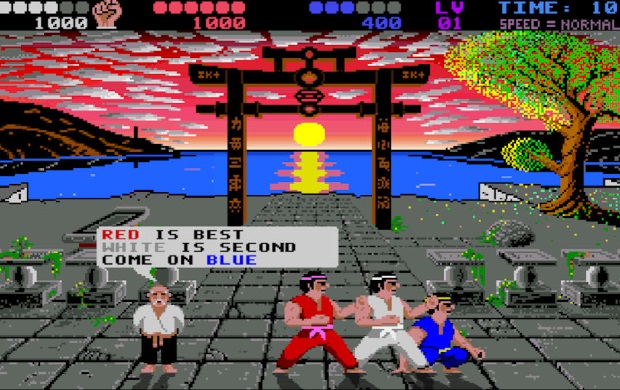
It was fiendishly addictive as there felt more to play for, especially as what the two computer players did to one another could change the result so dramatically, you had to really keep them under control. The two-player mode was also enhanced by the presence of this extra unpredictable threat. Between bouts, the wood smashing was replaced by a speed challenge where you fend off flying spheres with a shield. As treacherous as it is brilliant, I always thought it would’ve made a great budget game in itself.
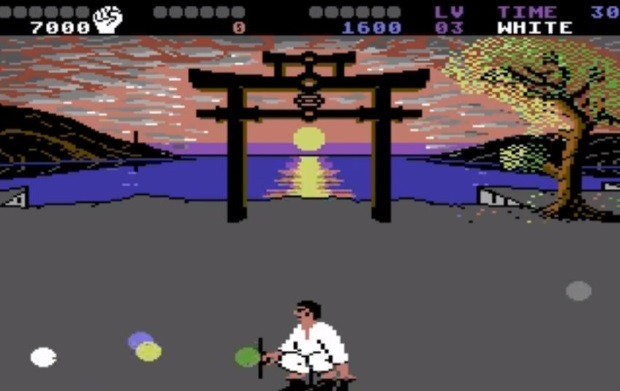
While there were no longer any international backdrops (as this would’ve overloaded the available RAM), the exchange was worth it. In addition to shimmering water in the sea (effective moving backgrounds still being very much a new thing), the control of the three fighters was more fluid than ever. It may not have had complex fighting moves to the extent of something like Exploding Fist but the ones it had felt brutal and believable, and watching three guys getting duffed up instead of two was way more violence. Yay.
The moves had the benefit of being simple to execute, so rather than button bashing in a panic, it felt like you could actually know what you were doing after a few minutes of playing the game. The moves also looked surprisingly “human,” thanks to MacLean hand-tracing over frames from VHS copies of Cannonball Run (for Jackie Chan’s headbutt) and Grease (for the side-on backflips) and converting these drawings to pixels.
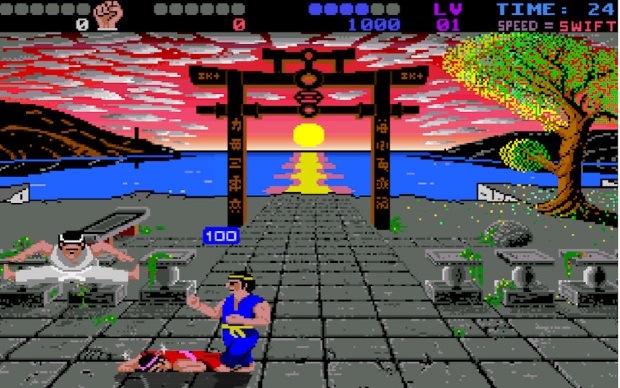
There are a couple of showstopping blows too and you score extra points for landing one of these, the ideal being a two directional jump kick where you leap into the air and boot both dudes in the head, one with each foot. Then, of course, just as you’re being proclaimed the winner, you can press the secret keys and get a victory trouser drop. Now that’s what I call style.
Like many of MacLean’s games, International Karate Plus remains a standout in its field and one of the most enjoyable cracks at bringing martial arts into home computing.